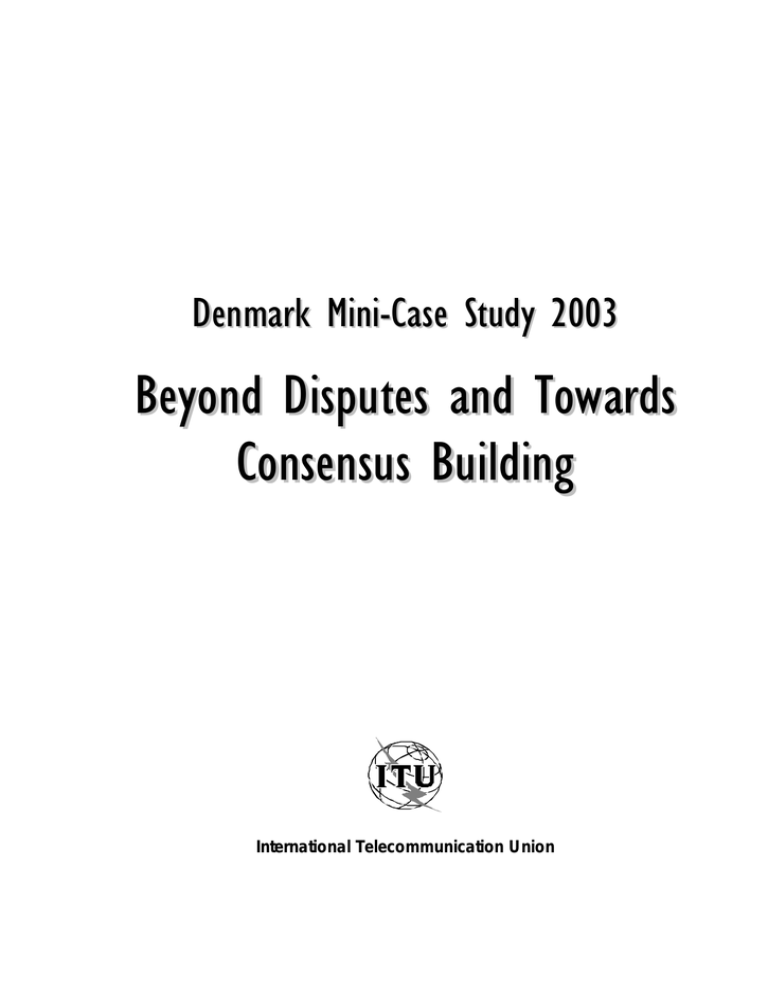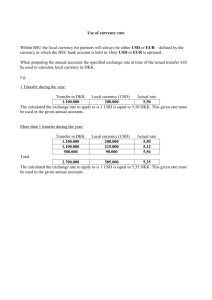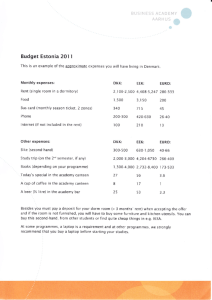B e y o
advertisement

Denmark Mini-Case Study 2003 Beyond Disputes and Towards Consensus Building International Telecommunication Union This mini case study was conducted by Robert Bruce and Rory Macmillan of Debevoise & Plimpton, London U.K. with the active participation of country collaborators Joergen Abild Andersen, Lars Sten Jørgensen, Cecile Christensen and Niels Henrik Jensen. The views expressed in this paper are those of the authors, and do not necessarily reflect the views of ITU, its members or the government of Denmark. The authors wish to express their sincere appreciation to the National IT and Telecommunications Agency for its support in the preparation of this mini case study. This is one of five mini case studies on interconnection dispute resolution undertaken by ITU. Further information can be found on the web site at http://www.itu.int/ITU-D/treg. © 2003 ITU International Telecommunication Union Place des Nations CH-1211 Geneva, Switzerland Denmark Mini-Case Study: Beyond Disputes and Towards Consensus Building I. Introduction Situated in Northern Europe, Denmark has a population of over 5 million and a GDP of about US$ 136 billion. It has over 3.7 million fixed line subscribers, a teledensity of about 70%, and about 4.5 million mobile subscribers, a penetration rate of about 84%. As a member of the European Union (EU), Denmark’s telecommunications sector is fully liberalized. The National IT and Telecom Agency (NITA) in Denmark oversees one of the most dynamic and efficient telecommunications sectors in Europe through a light-handed approach to regulation that may provide many useful insights for regulators in both developed and developing markets. NITA was established in April 2002 through a merger of the State Information Services and the former National Telecom Agency (NTA). NITA is part of the Danish Ministry of Science, Technology and Innovation and is responsible both for regulating and overseeing the provision of telecommunications infrastructure and services in Denmark, as well as for a cluster of policies concerning the development of Denmark as a leading IT and knowledge society. NITA is, however, independent of the Ministry in relation to NITA’s functions vis-à-vis the telecommunications sector. NITA’s mandate is driven by a new vision of convergence between the telecommunications and IT sector more than one based on integration of the telecommunications and traditional media sectors. It also has a mandate to address how new ICT services might have an impact on the performance of the Danish public sector and private sectors. Though NITA’s mandate is broad, the commentary below is substantially focused on how NITA is addressing a more traditional agenda of telecommunications sector-related regulatory issues. It is useful, however, to consider how NITA’s regulatory initiatives and overall approach have been influenced by its oversight responsibilities for the traditionally less regulated IT sector. This note is focused, in particular, on recent initiatives and developments on the part of NITA that might be of interest and relevance to other telecommunication regulatory agencies that may have a narrower focus on the regulation of telecommunication infrastructure and services. II. Recent Danish Developments (a) Recent NITA Overview of Sector Developments: Standing Back and Taking a Long View at Sector Problems During the first half of 2003, NITA has been in what might be fairly regarded as an unprecedented exercise of consultation with all the players in the Danish telecommunications sector to assess potential problems, impediments, and conditions giving rise to disputes and deadlock in the sector. Early in the year, NITA conducted a wide-ranging set of hearings with all the telecommunications players including incumbent fixed line operator TDC (formerly known as Tele Danmark), mobile operators and other service providers, as well as user organizations, to understand different perspectives on problems impeding competition in the sector. NITA has recently published a lengthy report in Danish outlining the findings and conclusions of its inquiry. 1 The purpose of the report was to identify any barriers to a wellfunctioning telecommunications market with a view to closing gaps in current regulation. In response to NITA’s invitation, the agency received about 20 contributions from the industry, which pointed out a variety of barriers to competition in various sub-areas of the telecommunications market. 1 An English summary is available from NITA’s website at: http://www.nt a.dk/image.asp?page=image&objno=133331692 -1 - 09.09.2003 The report points to a number of specific initiatives intended to assist in removing the barriers identified by NITA’s analyses. NITA's analyses showed that to a wide extent the existing regulation was sufficient for handling the identified barriers in general. However, this presupposed that NITA have a stronger involvement with the industry. The authority of NITA was restated in the bill introduced into Parliament in January 2003 for the purpose of implementing the new EU package of regulatory directives on electronic communications. 2 However, in relation to certain parts of the telecommunications market, the report’s analyses indicated a need for strengthening or amending existing legislation. This was so particularly with regard to improving competitive terms in the ADSL market. In other areas, for instance in relation to consumer regulation, the analyses showed that there may be a need for new initiatives although reaching decision on this was not within the scope of the report. NITA’s analyses, then, identified a number of specific issues where in-depth examinations was desirable, e.g. via dialogue with the industry. In addition, NITA has undertaken a renewed assessment of the markets analyzed in a survey published by NITA in May 2002, and has further assessed how price cap regulation in itself affects the competitive situation. NITA has concluded that in relation to the domestic traffic market, there is a case for considering rolling back the minute charging of domestic traffic. Furthermore, NITA's analyses pointed to a need to use alternative forms of regulation and strengthen the dialogue with the industry. (This conclusion has been followed up by a political decision that implies a rollback of regulation of domestic traffic tariffs as from 25 July 2003.) The barriers identified indicate a need to intensify cooperation and dialogue, both between NITA and the industry, and within the industry itself. Thus NITA has suggested the establishment of a new industry consultative forum that will be known as TeleForum. In addition, the report pointed to the need to create a greater degree of transparency in relation to existing regulation. What is innovative and intriguing about the recent NITA initiative is its attention to taking a step back from the status quo and getting participants seeking fresh approaches to old areas of controversy. It reflects a focus on de-compartmentalizing issues and looking beyond specific dockets or case files and trying to establish on a sector-wide basis a new set of rules of engagement through agreement and consensus building. NITA reports that they have briefed other European regulators on this initiative at meetings of the Independent Regulators Group (IRG),3 an informal group of European regulators, and that this initiative is regarded as novel and very noteworthy. It reflects as well a perspective shared by a growing number of other regulators around the world that the key tasks of the regulator can be addressed in the context of a negotiating session with protagonists, not merely in a traditional adversarial setting. It will be significant to see how NITA’s involvement in the TeleForum unfolds in the coming months and how it may affect the attitudes of key industry players and their approach to dealing with disputes. (b) Implementation of the New EU Regulatory Framework Another key challenge facing NITA involves the implementation of the new EU regulatory framework, which is required to be put in place as of July 25, 2003. With the basic steps in place and considerable planning undertaken, NITA has been conducting a survey of key relevant markets as is required by the new EU framework. NITA has been doing so through cooperation with the industry, including several public hearings, to ensure the transparency of the future regime. 2 The European Commission issues a series of directives governing the regulation of electronic communications in July 2002. These directives were to be transposed into the national law of the 15 European Union M ember States by 25 July 2003. 3 The IRG website can be found at http://irgis.icp.pt/site/en/index.asp -2 - 09.09.2003 The new framework will require NITA to look beyond whether a particular telecommunications provider, including an incumbent telecommunications provider in particular, has significant market power. Instead, the focus will be on the existence of market power in specific relevant markets. An analysis showing that effective competition has emerged in a relevant market segment will mean removal of all current regulatory obligations imposed on telecommunications providers operating in that market. What is significant is that regulatory initiatives are likely to become more targeted and focused on particular regulatory impediments or bottlenecks such as the provision of raw copper or unbundled local loops. In significant respects, the new regulatory framework will result in national regulators like NITA focusing on the same issues and regulatory concerns that had occupied their attention under the prior regulatory framework. However, the implementation of the new regulatory approach mandated by the European Commission is expected to impose significant new demands on the resources of national regulators in so far as they are required to conduct more empirically oriented studies of particular market segments. (c) Continuing Use of Benchmarking Data by NITA NITA has for many years been using benchmark data in reviewing the pricing of interconnection and other services offered by the incumbent operator. NITA uses this instrument, which is established by the law for setting prices in Denmark, by comparing prices in either 1 or 3 other countries. Due to this instrument Denmark has been able to continuingly have among the lowest prices in Europe. Typically, NITA has looked at pricing in several neighboring markets including Norway or Sweden, for example, where market and other competitive conditions may be considered to be comparable to those in Denmark. In this way, NITA has been able to extrapolate from the experience of other markets. The Danish regulator is effectively using the results generated in other markets as an alternative to undertaking an independent cost analysis of the provision of services in the Danish market. Benchmarking has also been used in a more formal complaint oriented setting. Often, NITA has found that information is not readily available from the EU or from public sources and has been required to undertake special studies. NITA has begun to work increasingly through the IRG to develop common or shared data bases of information. One of the issues that may warrant further discussion with NITA and other regulators is the overall process by which benchmark data is collected and made available for the use of third parties. (d) Development of LRAIC Model NITA has also developed as a regulatory tool a Long Run Average Incremental Cost (LRAIC) model which is used in analyzing the cost of interconnection services provided by TDC including in particular local loop elements. The modeling process started in year 2000 and, through collaborative discussions involving both NITA as well as TDC and new entrants, the first LRAICbased interconnection charges were implemented on 1 January 2003. TDC contributed to the process by developing a model reflecting its costs calculated through a top-down, historical cost methodology. In turn, other industry players developed an engineering-oriented, forward looking approach to costing out components of the local network on a current cost basis. This bottom-up model served as the starting point for NITA's hybrid model before the subsequent consolidation with TDC's top down mode l. Through extensive involvement and consultation of the market players, NITA has no doubt been working to establish both the long-term acceptability and credibility of an internal cost model. In effect, the LRAIC cost model has become an effective tool which complements other cost measuring tools, i.e., external benchmarking data and historical costs to assess the reasonability of service offerings by the incumbent operator.4 4 See http://www.itst.dk/wimpdoc.asp?page=tema&objno=95024371 for NITA’s top -down and bottom-up models and general guidelines. The Table of Contents of this document are provided as Annex 1 to this report. Annex 2 provides international LRAIC links. -3 - 09.09.2003 (e) Oversight of Mobile Termination Rates Unlike a number of other administrations including Oftel in the United Kingdom, TelecomControl-Commission (TKK) (the Austrian regulator) and the European Commission, NITA has not been active in the regulation of mobile termination rates. The mobile termination rates in Denmark are currently below the EU average and below those in the United Kingdom that have been subjected to close regulatory oversight. As a consequence of the implementation into Danish law of the EU's new regulatory framework for electronic communications networks, price control is now a remedy—among others— that NITA can impose on mobile operators designated as having a strong market position in the market for mobile call termination. Imposition of price controls will depend on the results of a market review process that NITA was conducting at the time this report was published. Decisions concerning the review of the mobile markets, including the mobile call termination market, are expected in the second quarter of 2004. (f) Reliance on Transparency and Wide Dissemination of Pricing and Interconnect Information NITA has, as a matter of practice, tended to take a more informal approach to price regulation than many of its European peer regulators such as Oftel. It has tended to rely on significant public posting of pricing and interconnection related information (see Annex 3).5 Likewise, NITA gathers and publishes the details of interconnection agreements so that other operators can assure themselves that they are being dealt with on a non-discriminatory basis. Interestingly, disclosure and competitive peer pressure themselves have become significant regulatory tools. End users are also able to determine the lowest price for services. NITA maintains an interactive guide based on a database that allows consumers to calculate which carrier tariff will be best to serve the user's interest given his or her usage patterns of a service. The guide contains information on tariffs with regard to fixed network services, mobile communications services and Internet, including broadband services. Besides this guide NITA provides a guide on quality of Internet services, aimed at providing consumers with an overview of Internet services. Among other things, this makes it possible for the consumer to measure the speed of the consumer's Internet service. A new guide dealing with quality of telecommunications services in general is under preparation. (g) Selective Use of Dispute or Complaint Proceedings Though most of the initiatives described in this report depend on the use of multilaterally oriented proceedings, NITA has also used complaint proceedings to address more general regulatory issues. An example of this is NITA’s ADSL investigation in 2002. In view of TDC's growing market share in the ADSL market, NITA held a number of meetings with the ADSL providers at the end of 2001 for the purpose of determining more precisely whether the increase in TDC's market share was due to natural competitive conditions or whether it might be influenced by other circumstances. The ADSL providers suggested that there might be problems of discrimination regarding TDC’s delivery times and terms of delivery of ADSL services. 5 See http://www.itst.dk/wimpdoc.asp?page=tema&objno=95024368 for interconnection rates generally and http://www.itst.dk/wimpdoc.asp?page=tema&objno=95024370 for documents relating to TDC’s final network interconnection prices. -4 - 09.09.2003 In the spring of 2002, jointly with the accountancy firm KPMG C. Jespersen, NITA carried out an analysis of TDC's administrative procedures in connection with the provision of ADSL-related interconnection products. The report was published on 15 July 2002. Based on the report, it was concluded that TDC's administrative procedures did not involve any discrimination between TDC Internet and other providers. However, in continuation of the conclusions of the report, NITA asked TDC to establish better administrative procedures in cooperation with the other providers. The visibility afforded by the previous initiatives inevitably contributes to a climate in which public operators are subjected to informal and indirect pressures to adjust their practices. (h) Use of Interconnection Forum: Local Loop Unbundling NITA’s recent proposed creation of a TeleForum is not actually an entirely new initiative on its part. For a number of years, NITA and its predecessor agency, the National Telecom Agency, encouraged reliance on an Interconnection Forum among all Danish players. Over the years, the national regulator convened informal gatherings to discuss differences in approach with respect to interconnect issues and often acted in the role of an informal mediator. (i) Mediation Under the Danish telecommunication legislation, NITA may act as mediator if two parties have negotiated without reaching an agreement on interconnection for more than three months. This possibility has been used several times with success. All mediations so far have ended with the parties reaching an agreement. Denmark has been favored with a comparatively limited amount of administrative proceedings involving interconnection issues or even of administrative or judicial appeals of agreements reached in this area. The reasons for this cooperative approach to regulatory dispute resolution may be largely cultural and attributable to the fact that the country is small and homogenous. In addition, the regulatory agency has often been in a position in the face of deadlocks to resort to legislative relief to back up a proposed regulatory initiative. For example, the Danish Parliament passed a law specifically giving the authority to NITA to order unbundling, illustrating how vital it is for regulators to have political support for their decisions. This may be one of the explanations for the fact that Denmark had a leading role in initiatives to unbundle the local loop and that the unbundling process has largely been unmarred by controversy. Another explanation may be that historically local retail rates in Denmark were significantly rebalanced partly as a result of the historical anomaly that TDC was formed out of a group of regional companies that had been independent of the long distance and international company and that the local companies had to ensure the financial and economic viability of their local tariffs. Consequently, Denmark may have avoided the situation facing Deutsche Telekom where for historical and later strategic reasons local rates were not significantly rebalanced with the result that local loop elements were then priced “at cost” by Deutsche Telekom at levels above the regulated rate levels. The dynamics of the Danish experience are then significant to assess. The question for other policymakers may well be whether the explanation for the success of low key and cooperative regulatory initiatives is cultural or merely the result of a set of deliberate initiatives to encourage parties to consider their dealings in a commercial context. It may well be that a sensible, forward looking, pragmatic approach to regulation that does not impose onerous regulatory conditions but relies instead on publication of interconnection rates and consumer tariffs to beat down prices through competitive peer pressure will generate its own following among operators. It is unquestionably the case that the behavior of participants in markets or in regulatory settings is inter-dependent and that aggressive behavior by one participant is likely to meet with an equivalent response. -5 - 09.09.2003 In that respect, low key Danish style regulation may be exportable into other jurisdictions including those where the prevailing approach to controversy is quite divergent from the Danish modus operandi. It may be, of course, necessary and useful to export Danish “regulatory peacekeepers” –as well as some of their cooperatively oriented methodologies—to help establish a new style and approach. Some of the tools such as reliance on benchmarking and cooperative fora, may also have more general applicability. (j) Private Dispute Resolution in Consumer Cases The use of innovative techniques is not restricted, moreover, to disputes between carriers and service providers. Until 25 July 2003 NITA has handled certain complaints regarding disputes between individual consumers and service providers. However, as from 25 July 2003, all consumer complaints regarding telecommunications issues are to be handled by a new independent, private complaints board established by the telecommunications providers and the Consumers Council. The activities of the board are financed by the industry. (k) NITA as “Modern Regulatory Agency” NTIA may well be an interesting template for a more modern, state-of-the-art regulatory agency. Its mandate reaches not only to the provision of telecommunication infrastructure and services but to the launching of IT services as well. The IT sector is one that has historically been “regulated” by private sector led, “West Coast” style regulation – i.e., industry-led regulation such as the development of protocols. As the telecommunication sector moves inexorably from what one international observers refers to as the “telephone age” to the “Internet age”, it may be appropriate for the procedures and policies of regulation to change as well and become more flexible and more driven by private sector initiatives. The regulator’s role may be as a regulator of process –of facilitation of appropriate inter-industry initiatives. In this respect, NITA’s consultative initiatives and success in mediating tensions between sector participants offer valuable lessons. -6 - 09.09.2003 ANNEX 1 Table of Contents for LRAIC Model Reference Paper “Guidelines for the Top-Down Cost Analysis”. http://www.itst.dk/wimpdoc.asp?page=tema&objno=95024371 LRAIC MODEL REFERENCE PAPER GUIDELINES FOR THE TOP-DOWN COST ANALYSIS Non-binding English translation 6 April 2001 National Telecom Agency Table of Contents CHAPTER 1 INTRODUCTION.............................................................................................................................1 1.1 OUTLINE OF THIS PAPER................................................................................................................................1 CHAPTER 2 AN OVERVIEW OF TOP-DOWN MODELLING.................................................................3 2.1 2.2 2.3 2.4 DERIVING HOMOGENOUS COST CATEGORIES ...........................................................................................3 IDENTIFYING AND QUANTIFYING SERVICE USAGE OF COST CATEGORIES ...........................................3 DEVELOPING COST -VOLUME RELATIONSHIPS..........................................................................................4 DEVELOPMENT OF THE M ODEL ....................................................................................................................4 PART A: MEASURING COSTS ............................................................................................................................6 CHAPTER 3 GROSS ASSET VALUATION......................................................................................................7 3.1 3.2 CURRENT COST A CCOUNTING......................................................................................................................7 REPLACEMENT COST .....................................................................................................................................8 3.2.1 3.2.2 3.3 A LTERNATIVES TO REPLACEMENT COST .................................................................................................10 3.3.1 3.3.2 3.4 3.5 Existing technology ................................................................................................................................8 New technology ......................................................................................................................................9 Assets with low values or short lives....................................................................................................10 Net realisable value .............................................................................................................................11 EFFICIENCY ...................................................................................................................................................11 CAPITALISED INTEREST ...............................................................................................................................13 CHAPTER 4 VALUATION OF MAJOR ASSET CLASSES ..................................................................... 14 4.1 A CCESS NETWORK.......................................................................................................................................14 4.1.1 4.1.2 4.1.3 4.1.4 4.2 CORE NETWORK...........................................................................................................................................16 4.2.1 4.2.2 4.2.3 4.3 4.4 Exchanges ............................................................................................................................................16 Transmission equipment ......................................................................................................................17 Optical fibre.........................................................................................................................................17 TRENCHING COSTS.......................................................................................................................................18 INDIRECT NETWORK COSTS........................................................................................................................18 4.4.1 4.4.2 4.4.3 4.5 4.6 Copper cable ........................................................................................................................................14 Optical fibre.........................................................................................................................................15 Radio ....................................................................................................................................................15 Line cards.............................................................................................................................................16 Land and buildings...............................................................................................................................19 Power equipment and air conditioning................................................................................................19 Interconnection specific costs ..............................................................................................................19 OTHER INDIRECT COSTS.............................................................................................................................19 CO-LOCATION...............................................................................................................................................20 CHAPTER 5 MEASURING PROFITS ............................................................................................................. 21 5.1 5.2 5.3 INTRODUCTION.............................................................................................................................................21 CAPITAL M AINTENANCE .............................................................................................................................21 IMPLICATIONS OF THE FCM CONCEPT......................................................................................................24 5.3.1 5.3.2 Updating the model ..............................................................................................................................24 General Price Inflation ........................................................................................................................24 CHAPTER 6 ANNUALISATION METHODOLOGIES ............................................................................. 25 6.1 6.2 6.3 6.4 INTRODUCTION.............................................................................................................................................25 A NNUALISATION CRITERIA.........................................................................................................................25 ECONOMIC DEPRECIATION .........................................................................................................................25 A LTERNATIVES TO ECONOMIC DEPRECIATION........................................................................................28 6.4.1 6.4.2 6.4.3 6.5 Annuities...............................................................................................................................................29 Straight-line depreciation ....................................................................................................................29 Sum of digits .........................................................................................................................................30 NUMERICAL COMPARISONS OF THE DIFFERENT M ETHODOLOGIES......................................................30 6.5.1 Comparisons with economic depreciation ...........................................................................................30 National Telecom Agency Table 6.1: Comparisons of Alternative Annualisation Methodologies ............................................................32 6.5.2 Coping with price changes ...................................................................................................................33 6.5.3 Some Interim Conclusions ...................................................................................................................34 6.6 OTHER ISSUES...............................................................................................................................................34 6.6.1 6.6.2 6.6.3 6.7 Annualisation of Relatively New Assets ...............................................................................................34 Fully Depreciated Assets .....................................................................................................................35 Top-Down and Bottom-Up Annualisation Methodologies...................................................................36 CONCLUSIONS...............................................................................................................................................36 CHAPTER 7 NET ASSET VALUATION......................................................................................................... 37 7.1 7.2 A PPLICATION OF HISTORIC COST NET TO GROSS BOOK VALUES ........................................................37 THE ROLLING-FORWARD M ETHODOLOGY...............................................................................................38 Table 7.2 – An Illustrative Example of the Rolling Forward Methodology ........................................................39 7.3 A SSETS IN THE COURSE OF CONSTRUCTION ............................................................................................40 CHAPTER 8 WORKING CAPITAL ................................................................................................................. 41 8.1 CALCULATING THE COST OF W ORKING CAPITAL ...................................................................................41 CHAPTER 9 OPERATING COSTS................................................................................................................... 43 9.1 9.2 9.3 CLASSES OF OPERATING COSTS.................................................................................................................43 EFFICIENTLY INCURRED COSTS.................................................................................................................44 A CTIVITY BASED A LLOCATION OF OPERATING COSTS..........................................................................45 PART B: COSTING SERVICES ......................................................................................................................... 47 CHAPTER 10 COSTING S ERVICES ............................................................................................................... 48 10.1 DERIVING HOMOGENEOUS COST CATEGORIES .......................................................................................48 10.2 IDENTIFYING AND QUANTIFYING SERVICE USAGE .................................................................................48 10.2.1 10.2.2 10.2.3 10.2.4 10.2.5 10.2.6 Trenching and duct ..............................................................................................................................49 Copper and fibre cable ........................................................................................................................49 Local exchanges ...................................................................................................................................49 Tandem exchanges ...............................................................................................................................50 Transmission Equipment......................................................................................................................50 Indirect network costs and overhead costs ..........................................................................................51 10.3 COST -VOLUME RELATIONSHIPS................................................................................................................51 10.3.1 10.3.2 10.3.3 Alternative cost-volume relationships..................................................................................................52 Developing cost-volume relationships .................................................................................................53 CVRs where a class of asset has two or more drivers.........................................................................54 10.4 A SSIGNING COSTS TO SERVICES................................................................................................................54 10.4.1 10.4.2 Calculating incremental cost ...............................................................................................................54 Calculating costs of services within an increment...............................................................................55 CHAPTER 11 GENERAL COSTING ISSUES ............................................................................................... 56 11.1 11.2 11.3 11.4 11.5 OTHER INCREMENTS....................................................................................................................................56 ROUTING FACTORS AND M EASUREMENT OF SERVICE COST .................................................................57 SET -UP AND DURATION RELATED CHARGES ..........................................................................................58 GEOGRAPHICAL DE-AVERAGING...............................................................................................................59 THE TREATMENT OF COMMON COSTS......................................................................................................59 PART C: MODEL FUNCTIONALITY............................................................................................................. 62 CHAPTER 12 MODEL FUNCTIONALITY ................................................................................................... 63 12.1 12.2 12.3 12.4 THE LEVEL OF TRANSPARENCY REQUIRED IN THE M ODEL...................................................................63 M AJOR OUTPUTS OF THE M ODEL ..............................................................................................................63 THE BREAKDOWN OF COSTS......................................................................................................................64 M ODEL FLEXIBILITY....................................................................................................................................65 CHAPTER 13 CRITERION ................................................................................................................................. 69 APPENDIX ...................................................................................................................................................................1 ANNEX 2 International LRAIC Links http://www.itst.dk/wimpdoc.asp?page=tema&objno=95025297 LRAIC-links Page 1 of 2 LRAIC-links International links Portugal Economic cost model for the fixed telecommunications network (The Hybrid Cost Proxy Model) http://www.icp.pt/info/noticia.asp?id=1465&ida=182 http://www.icp.pt/actual/MapasInputsuk.xls. Great Britain l l l l l l l l OFTEL documents relevant to Incremental Costs: http://www.oftel.gov.uk/internat/lric498.htm OFTEL's submission to the Monopolies and Mergers Commission inquiry into the prices of calls to mobile phones (May 1998) http://www.oftel.gov.uk/pricing/mmc0598.htm Access to Bandwidth: Delivering Competition for the Information Age (November 1999) http://www.oftel.gov.uk/competition/a2b1199.htm AN ASSESSMENT OF THE INTERIM 1996/7 TOP DOWN MODEL - A Report for OFTEL prepared by NERA (July 1997) http://www.oftel.gov.uk/pricing/td797.htm Access to Bandwidth: Indicative prices and pricing principles (May 2000) http://www.oftel.gov.uk/competition/llu0500.htm Access to Bandwidth : Conclusions on charging principles and further indicative charges (August 2000) http://www.oftel.gov.uk/competition/a2b0800.htm Access to Bandwidth: Shared access to the local loop: Consultation Document on the implementation of shared access to the local loop in the UK (October 2000) http://www.oftel.gov.uk/competition/shac1000.htm Consultation and draft Determination on charges for Metallic Path Facilities and Internal Tie Cables (November 2000) http://www.oftel.gov.uk/pricing/llup1100.htm Germany l Analytical Cost Model http://www.regtp.de/en/reg_tele/start/in_05-07-00-00-00_m/fs.html USA FCC - Common Carrier Bureau - Competitive Pricing Division http://www.fcc.gov/ccb/cpd.html l The HCPM/HAI Synthesis Cost Proxy Model http://www.fcc.gov/ccb/apd.hcpm/ l Switzerland Wholesale - Long-run Incremental Cost (LRIC) http://www.swisscom.com/ws/content/products/interconnection/lric/index_EN.html Austria Cost orientation for interconnection in mobile networks http://www.tkc.at/www/presspub.nsf/83e9f45c11caa9d58525647300561fe6/f8af89ec86f f2d69c125694a00260bf1/$FILE/CostOrientationIC.pdf Unbundling of the Local Loop in Austria http://www.tkc.at/www/presspub.nsf/83e9f45c11caa9d58525647300561fe6/f8af89ec86f http://www.itst.dk/wimpprint_uk.asp?page=tema&objno=95025297 12.10.2003 LRAIC-links Page 2 of 2 f2d69c125694a00260bf1/$FILE/UnbundlingLocalLoop.pdf Geographically averaged rates in the context of Local Loop Unbundling http://www.tkc.at/www/presspub.nsf/83e9f45c11caa9d58525647300561fe6/f8af89ec86f f2d69c125694a00260bf1/$FILE/GeographicallyLocalLoop.pdf Interconnection/FL-LRAIC http://www.tkc.at/www/Presspub.nsf/pages/KonsIC2000-e Bottom Up Model http://www.tkc.at/www/presspub.nsf/pages/KonsIC2000-BottUp-e Australia Estimating the Long Run Incremental Cost of PstnAccess (Final Nera Report) http://www.accc.gov.au/telco/nera.zip Ireland lric http://www.consult.odtr.ie/secure/consultation/lric.htm The development of Long Run Incremental Costing for interconnection - Decision Notice D6/99 & report on consultation paper ODTR 99/17 http://www.odtr.ie/docs/odtr9938.doc The development of Long Run Incremental Costing for interconnection - consultation paper http://www.odtr.ie/docs/odtr9917.doc Report on the ODTR Consultation on Local Loop Unbundling - Decision Notice D6/00 http://www.odtr.ie/docs/odtr0030.doc EU April 2000 - Final Report on the Study of an adaptable "bottom-up" model capable of calculating the forward-looking, long-run incremental costs of interconnection services for EU Member States, prepared for the European Commission by European Economic Research Ltd (Europe Economics). This Study has resulted in the production of a model spreadsheet in MS-Excel format http://www.ispo.cec.be/infosoc/telecompolicy/en/Cost_model_2000.xls (with a voluminous User Guide) which is described in the Main Report: http://www.ispo.cec.be/infosoc/telecompolicy/en/lricmain.pdf and an Executive Summary: http://www.ispo.cec.be/infosoc/telecompolicy/en/lricexsum.pdf Printed from: www.itst.dk, 12.10. 2003, 12:37:07 PM All rights reserved IT- og Telestyrelsen. The information may only be used for personal non-commercial purposes. Location of article: http://www.itst.dk/wimpdoc.asp?page=tema&objno=95025297 http://www.itst.dk/wimpprint_uk.asp?page=tema&objno=95025297 12.10.2003 ANNEX 3 TDC’s Final Network Interconnection Rates. 10-10-03 Interconnection in the fixed network Prices as of 1 January 2003 (DKK/100) set by the NRA: Access in fixed Local interconnect Within network tariffs interconnect areas Peak Dkk 0.0308 Dkk 0.0411 Off-peak Dkk 0.0163 Dkk 0.0217 Charge per call Dkk 0.0201 Dkk 0.0287 Between interconnect areas Dkk 0.052 Dkk 0.0275 Dkk 0.0373 Termination In fixed network Peak Off-peak Charge per call Between interconnect areas Dkk 0.052 Dkk 0.0275 Dkk 0.0373 Local interconnect tariffs Dkk 0.0264 Dkk 0.0139 Dkk 0.0201 Within interconnect areas Dkk 0.0411 Dkk 0.0217 Dkk 0.0287 Interconnection within mobile/fixed networks Fixed Interconnection charges between operators as of May 2000: Termination Access Fixed to mobile Mobile to fixed Peak Dkk 1.20 Dkk 1.38 Off-peak Dkk 0.60 Dkk 0.69 Charge per call Dkk 0.08 Dkk 0.08 Interconnection in the fixed network Prices per 1 March 2002 (DKK/100) set by the NRA: Access in fixed Local interconnect Within network tariffs interconnect areas Peak Dkk 0.038 Dkk 0.0607 Off-peak Dkk 0.0211 Dkk 0.0322 Charge per call Dkk 0.02 Dkk 0.03 Between interconnect areas Dkk 0.0904 Dkk 0.0479 Dkk 0.03 Termination In fixed network Peak Off-peak Charge per call Between interconnect areas Dkk 0.0904 Dkk 0.0479 Dkk 0.03 Local interconnect tariffs Dkk 0.033 Dkk 0.017 Dkk 0.02 Within interconnect areas Dkk 0.0607 Dkk 0.0322 Dkk 0.03 Interconnection in the fixed network Prices per January 1st 2001 (DKK/100) set by the NRA: Termination/ Local interconnect Within Access in fixed tariffs interconnect areas network Peak Dkk 0.0397 Dkk 0.0607 Off-peak Dkk 0.0206 Dkk 0.0322 Charge per call Dkk 0.03 Dkk 0.03 Interconnection in the fixed network Prices as per May 2000: Termination/ Local interconnect Access in fixed tariffs network Peak Dkk 0.0460 Off-peak Dkk 0.0244 Charge per call Dkk 0.03 Interconnection in the fixed network Prices as per October 1999: Between interconnect areas Dkk 0.0904 Dkk 0.0479 Dkk 0.03 Within interconnect areas Between interconnect areas Dkk 0.0607 Dkk 0.0322 Dkk 0.03 Dkk 0.0904 Dkk 0.0479 Dkk 0.03 10-10-03 Termination/ Access in fixed network Peak Off-peak Charge per call Local interconnect tariffs Within interconnect areas Between interconnect areas Dkk 0.049 Dkk 0.0245 Dkk 0.04 Dkk 0.068 Dkk 0.034 Dkk 0.06 Dkk 0.114 Dkk 0.057 Dkk 0.06 Within interconnect areas Between interconnect areas Dkk 0.104 Dkk 0.052 Dkk 0.06 Dkk 0.122 Dkk 0.061 Dkk 0.06 Within interconnect areas Between interconnect areas Dkk 0.11 Dkk 0.055 Dkk 0.08 Dkk 0.14 Dkk 0.07 Dkk 0.08 Interconnection in the fixed network Prices as per September 1999: Termination/ Local interconnect Access in fixed tariffs network Peak Dkk 0.056 Off-peak Dkk 0.028 Charge per call Dkk 0.04 Interconnection in the fixed network Prices as per October 1997: Termination/ Local interconnect Access in fixed tariffs network Peak Dkk 0.06 Off-peak Dkk 0.03 Charge per call Dkk 0.04



